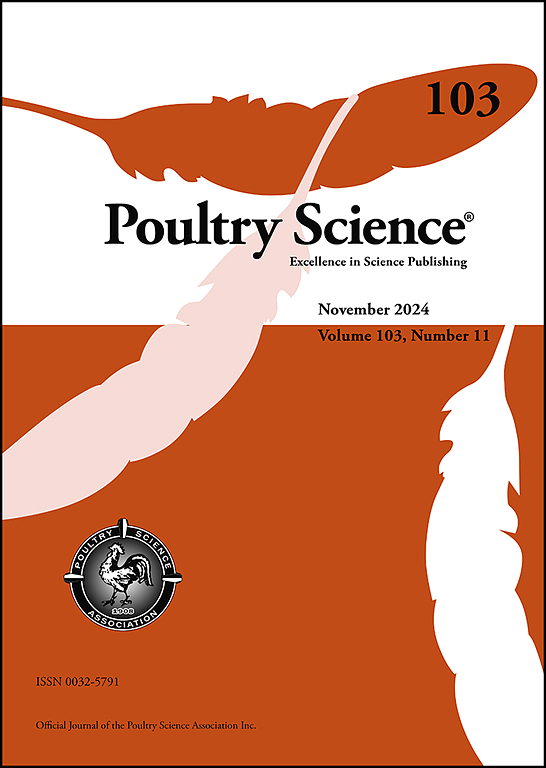Betaine decreases hepatic lipid deposition through DNA 5 mC and RNA m6A methylation-mediated regulation of fatty acid metabolic genes expression in laying hens
IF 4.2
1区 农林科学
Q1 AGRICULTURE, DAIRY & ANIMAL SCIENCE
引用次数: 0
Abstract
As a methyl donor, betaine participates in hepatic lipid metabolism in mammals. Nevertheless, it is unclear whether and how dietary betaine affects hepatic lipid metabolism in laying hens. The current research was conducted to explore the effect of dietary betaine on plasma and hepatic triglycerides (TGs) contents, mRNA and protein expression of fatty acid metabolic genes, and their DNA 5-methylcytosine (5mC) and RNA N6 methyladenosine (m6A) methylation levels in the liver of laying hens. Therefore, a total of 48 laying hens (130-d-old) were randomly assigned to two groups: control and betaine. Hens in control group were fed a corn-soybean meal basal diet without adding betaine, while hens in betaine group were fed the basal diet supplemented with 0.10 % betaine for 35 d. The results showed that dietary betaine decreased (P < 0.05) hepatic TGs content, associated with suppression (P < 0.05) of sterol regulatory element binding transcription factor 1 (SREBP1), fatty acid synthase (FASN) and stearoyl-CoA desaturase (SCD) genes expression, and activation of carnitine palmitoyl transferase 1A (CPT1A) gene expression in the liver. Furthermore, adding betaine to the diet led to higher (P < 0.05) 5mC methylation levels on FASN and SCD genes promoters, and lower (P < 0.05) 5mC methylation levels on CPT1A gene promoter. Besides, the m6A methylation level on the 3′ untranslated region of SREBP1 mRNA was found to be increased (P < 0.05) in betaine-treated chickens. It was concluded that dietary betaine reduces hepatic TGs deposition via DNA 5 mC and RNA m6A methylation-mediated regulation of fatty acid metabolic genes expression in laying hens.
甜菜碱通过DNA 5mc和RNA m6A甲基化介导的脂肪酸代谢基因表达调控降低蛋鸡肝脏脂质沉积
甜菜碱作为甲基供体参与哺乳动物肝脏脂质代谢。然而,目前尚不清楚甜菜碱是否以及如何影响蛋鸡肝脏脂质代谢。本试验旨在探讨饲粮中添加甜菜碱对蛋鸡血浆和肝脏甘油三酯(TGs)含量、脂肪酸代谢基因mRNA和蛋白表达及其DNA 5-甲基胞嘧啶(5mC)和RNA N6甲基腺苷(m6A)甲基化水平的影响。因此,将48只130 d龄蛋鸡随机分为对照组和甜菜碱组。对照组饲喂不添加甜菜碱的玉米-豆粕型基础饲粮,甜菜碱组饲喂在基础饲粮中添加0.10%甜菜碱的试验期35 d。0.05)肝脏TGs含量,与抑制相关(P <;肝脏中甾醇调节元件结合转录因子1 (SREBP1)、脂肪酸合成酶(FASN)和硬脂酰辅酶a去饱和酶(SCD)基因表达以及肉毒碱棕榈酰转移酶1A (CPT1A)基因表达的激活。此外,在日粮中添加甜菜碱可以提高(P <;0.05) FASN和SCD基因启动子的5mC甲基化水平,以及更低(P <;0.05) CPT1A基因启动子的5mC甲基化水平。此外,发现SREBP1 mRNA 3 '非翻译区m6A甲基化水平升高(P <;0.05)。由此可见,饲粮甜菜碱通过DNA 5mc和RNA m6A甲基化介导的脂肪酸代谢基因表达调控,减少了蛋鸡肝脏tg沉积。
本文章由计算机程序翻译,如有差异,请以英文原文为准。
求助全文
约1分钟内获得全文
求助全文
来源期刊

Poultry Science
农林科学-奶制品与动物科学
CiteScore
7.60
自引率
15.90%
发文量
0
审稿时长
94 days
期刊介绍:
First self-published in 1921, Poultry Science is an internationally renowned monthly journal, known as the authoritative source for a broad range of poultry information and high-caliber research. The journal plays a pivotal role in the dissemination of preeminent poultry-related knowledge across all disciplines. As of January 2020, Poultry Science will become an Open Access journal with no subscription charges, meaning authors who publish here can make their research immediately, permanently, and freely accessible worldwide while retaining copyright to their work. Papers submitted for publication after October 1, 2019 will be published as Open Access papers.
An international journal, Poultry Science publishes original papers, research notes, symposium papers, and reviews of basic science as applied to poultry. This authoritative source of poultry information is consistently ranked by ISI Impact Factor as one of the top 10 agriculture, dairy and animal science journals to deliver high-caliber research. Currently it is the highest-ranked (by Impact Factor and Eigenfactor) journal dedicated to publishing poultry research. Subject areas include breeding, genetics, education, production, management, environment, health, behavior, welfare, immunology, molecular biology, metabolism, nutrition, physiology, reproduction, processing, and products.
 求助内容:
求助内容: 应助结果提醒方式:
应助结果提醒方式:


